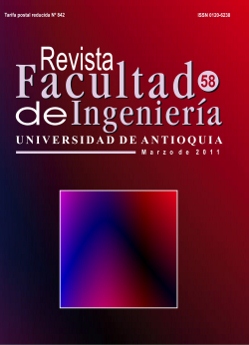Robot programming using the paradigm of learning by demonstration
DOI:
https://doi.org/10.17533/udea.redin.14608Keywords:
artifi cial vision, visuo-motor map, gesture imitation, robotic, learning by demonstrationAbstract
This paper presents the appl ication of the paradigm of learning by demonstration for robot programming. Algorithms use bio-inspired techniques to extract relevant information accompanying the demonstrator’s action. A visuo-motor map relates visual inputs to motor commands necessary to imitate a behavior or a task. The system was evaluated qualitatively using a survey, and quantitatively by specifi c metrics to score the quality of the imitation of a group of four gestures. Thus, the learning by demonstration potential for robot programming is corroborated, since the system was able not only to make their own interpretations of the gestures to be taught, but to use the skills learned in conducting novel gestures.
Downloads
References
A. N. Meltzoff. “Born to Learn: What infants learn from watching us”. The Role of Early Experience in Infant Development. L. A. L. N. A. Fox, and J. G. Warhol (Eds.), Ed. Skillman. Pediatric Institute Publications. New Jersey (USA). 1999. pp. 145-164.
B. G. Galef. “Imitation in animals: History, defi nition and interpretation of data from the psychological laboratory”. Social learning: Psychological and Biological Perspectives. T.R. Zentall & B. G. Galef, Jr. (editores.), Ed. Hillsdale. Lawrence Erlbaum. New
Jersey (USA). 1988. pp. 3-28.
A. Billard, Y. Epars, S. Calinon, S. Schaal, G. Cheng. “Discovering optimal imitation strategies”. Robotics and Autonomous Systems. Special Issue: Robot Learning from Demonstration. Vol. 47. 2004. 69-77. DOI: https://doi.org/10.1016/j.robot.2004.03.002
M. Cabido, J. V. Santos. “Visual Transformations in Gesture Imitation: what you see is what you do”. Proceedings IEEE International Conference on Robotics & Automation. Vol. 2. 2003. pp. 2375-2381.
D. H. Kim, H. S. Lee, M. J. Chung. “Biologically Inspired Models and Hardware for Emotive Facial Expressions”. International Workshop Robot and Human Interactive Communication. Agosto 13-15. 2005. pp. 679-685.
J. Zhang, B. Rössler. “Self-valuing learning and generalization of visual guided grasping”. Robotics and Autonomous Systems. Special Issue: Robot Learning from Demonstration. Vol. 47. 2004. pp. 117- 127. DOI: https://doi.org/10.1016/j.robot.2004.03.006
P. Bakker, Y. Kuniyoshi. “Robot See, Robot Do: An overview of robot imitation”. Workshop on Learning in Robots and Animals. Abril 1-2. 1996. pp. 3-11.
E. L. Thorndike. “Animal Intelligence”. B. G. Galef (editor) Imitation in animals: History, defi nition and interpretation of data from psychological laboratory. Ed. Macmillan. New York (USA). 1988. pp. 3-28.
S. Nope, H. Loaiza E. Caicedo. “Modelo Bio-inspirado para el reconocimiento de gestos usando primitivas de movimiento en visión”. Revista Iberoamericana de Automática e Informática Industrial (RIAI). Vol. 5. 2008. pp. 69-76. DOI: https://doi.org/10.1016/S1697-7912(08)70179-1
S. Nope, H. Loaiza E. Caicedo. “Reconstrucción 3D2D de Gestos usando Información de Vídeo Monocular Aplicada a un Brazo Robótico”. Rev. Fac. Ing Univ. Antioquia. Vol. 53. 2010. pp. 145-154.
R. L. DeVanois, M. C. Morgan, D. M. “Snodderly. Psychophysical studies of monkey vision. III. Spatial Luminance contrast sensitivity test of macaque and human observers.” Vision Research. Vol. 14. 1974. pp.53-67. DOI: https://doi.org/10.1016/0042-6989(74)90118-7
V. Bruce, P. R. Green, M. A. Georgeson. Visual Perception: Physiology, Psychology and Ecology. Cuarta Edición. Ed. Psycology Press, an imprint of Erlbaum (UK) Taylor & Francis Ltd. 2003. pp. 171-204.
M. Pomplun, J. Martinez Trujillo, E. Simine, Y. Liu, S. Treue, J. K. Tsotsos. “A Neurally-Inspired Model for Detecting and Localizing Simple Motion Patterns in Image Sequences”. Workshop on Dynamic Perception. Bochum (Alemania). Nov. 22-24. 2002. pp. 45-52.
A. F. Bobick, J. W. Davis. “The Recognition of Human Movement using Temporal Templates”. IEEE Transactions on Pattern Analysis and Machine Intelligence. Vol. 23. 2001. pp. 257-267. DOI: https://doi.org/10.1109/34.910878
S. Nope. Sistema Bio-inspirado de Reconocimiento e Imitación de Gestos Aplicado en Robótica. Tesis de doctorado. Facultad de Ingeniería. Universidad del Valle. 2008. pp. 45-66.
Y. Kuniyoshi, Y. Yorozu, M. Inaba, H. Inoue. “From visuo-motor self learning to early imitation - a neural architecture for humanoid learning”. International Conference on Robotics & Automation. Taipei (Taiwan). 2003. Vol. 3. pp. 3:3132-3139.
M. J. Mataric, M. Pomplun. “Fixation behavior in observation and imitation of human movement”. Cognitive Brain Research. Vol. 7. 1998. pp. 191-202. DOI: https://doi.org/10.1016/S0926-6410(98)00025-1
Downloads
Published
How to Cite
Issue
Section
License
Copyright (c) 2018 Revista Facultad de Ingeniería

This work is licensed under a Creative Commons Attribution-NonCommercial-ShareAlike 4.0 International License.
Revista Facultad de Ingeniería, Universidad de Antioquia is licensed under the Creative Commons Attribution BY-NC-SA 4.0 license. https://creativecommons.org/licenses/by-nc-sa/4.0/deed.en
You are free to:
Share — copy and redistribute the material in any medium or format
Adapt — remix, transform, and build upon the material
Under the following terms:
Attribution — You must give appropriate credit, provide a link to the license, and indicate if changes were made. You may do so in any reasonable manner, but not in any way that suggests the licensor endorses you or your use.
NonCommercial — You may not use the material for commercial purposes.
ShareAlike — If you remix, transform, or build upon the material, you must distribute your contributions under the same license as the original.
The material published in the journal can be distributed, copied and exhibited by third parties if the respective credits are given to the journal. No commercial benefit can be obtained and derivative works must be under the same license terms as the original work.










 Twitter
Twitter